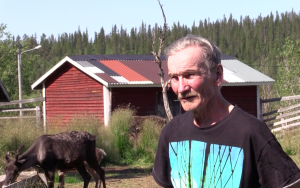In April 2017, after spending four days filming in Restad Gård, in what it was to be the largest refugee accommodation in Sweden, my colleague Patricio Burbano and I jumped on the Arctic train in Gothenburg heading toward the Arctic. I had asked Patricio, an accomplished camera and writer originally from Ecuador to accompany me in this first journey to the north of Sweden, a place neither of us has ever been before.
The Arctic Circle train travels from Gothenburg to Narvik along the Norwegian coast. This is one of the very last express trains travelling at night along the coast punctuated by the cities that were all new to us. Patricio and I had booked one of the compartments where we set out our filming base. The narrow and long corridors dotted with windowless doors, seem the perfect place to begin to tell the story of Khaled. This was a recce trip; we were there to find out about the different locations and meet people who I had contacted through the Internet. Kiruna was our final destination, a mining town whose houses were to be relocated two miles from its current position after years of iron mining underneath the municipality had rendered the earth geologically unable to support the weight of human activity.
We departed at 18:15 from Gothenburg and arrived at about 22:00 in Stockholm Central. The train’s shining exterior resembled the Greyhound buses that crossed the USA from the west to the east and vice versa.
Carrying minimal equipment was my idea so we could be as light as possible and move quickly from one place to another. I explained to Patricio in terms of the storyline, although it was pretty clear that I knew very little of what we were going to see.

As we left Stockholm, we started to feel the energy of this old-fashion train, in which speed was not the main reason people use it. It was Easter, so many Swedes were heading north to enjoy some days of skiing and trekking. Our intentions were different; we wanted to explore the train as a potential element in the story. In my mind, I was imagining the character sleeping as the outside lights flashed through the window into our room. There was nobody in the corridors, no sound other sound than the constant rattling as the train plowed through the icy night as we approached midnight. It felt as if we were the only ones travelling but then, suddenly, we stopped in Uppsala, and I could see people joining us on the night journey.

We continued recording in silence, mesmerised by the new objects or angles that the camera would discover in the squeezed space. The occasional whistle would remind us that, despite the rattling, we were advancing through the night. It started to snow gently; gradually, we could see more snow on the ground and eventually it covered the tree canopies. Sometimes we stopped our cameras and would look into each other’s eyes and smile: whatever the story was going to be, this place was right to start it.
It was around 04.30 when Patricio finally told me he was going to sleep. We had been filming since we left Stockholm and the darkness encouraged us to rest and recover energy. At 07:00, I woke, shaken by the swinging movement of the train car after we passed through a tunnel. I moved to the bistro car for a coffee. It was dawn, but Patricio remained sleeping. I opened my notebook and jotted words to express the sensations inside as the white landscape greeted us.

In London, I had contacted a group of young people who claimed asylum in the city of Kiruna. I never would have imagined that Middle Eastern refugees would end up in this remote and cold place. But I didn’t know many things…
One of the people that I contacted was Keith Larsson, an evolutionary ecologist and science communicator based in the Abisco Arctic Polar Station, near the Norweigian border. Keith had been working as a scientist traveling the world experiencing the impacts of climate and environmental change on ecosystems from the Arctic to the tropics. He seems the right person to meet on my first trip to this ecosystem.
He arrived on an unexpectedly sunny morning; the snow was strikingly white and reflecting all the sunlight and destroying our preconception of an Arctic as a place with a perennial overcast sky. We walked from Abisko train station to the Polar Research Centre where Keith welcomed us and introduced us to his research. He said he found life in extreme environments fascinating. He explained that many species that live at high elevations and latitudes do so because they have specific adaptations to survive in the environments. Many species show great flexibility for a large range of ecological conditions while others require quite narrow ones. I found his words resonating with the story I wanted to tell in my film, the deep adaptation I felt we, as a humankind, were going to increasingly experience in the following years. A fascinating and yet terrifying reality that had just started hitting many communities across the planet, not only humans.










